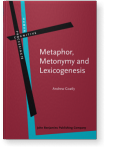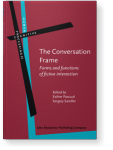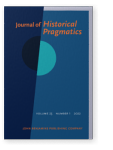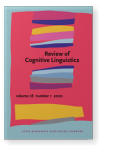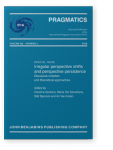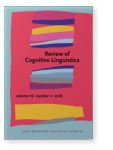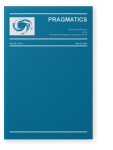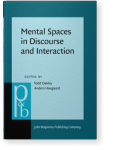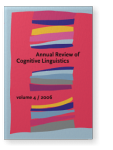Esther Pascual
List of John Benjamins publications for which Esther Pascual plays a role.
Book series
Journal
ISSN 2214-3157 | E-ISSN 2214-3165
Titles
The Conversation Frame: Forms and functions of fictive interaction
Edited by Esther Pascual and Sergeiy Sandler
[Human Cognitive Processing, 55] 2016. xi, 384 pp.
Subjects Cognition and language | Discourse studies | Pragmatics
Fictive Interaction: The conversation frame in thought, language, and discourse
Esther Pascual
[Human Cognitive Processing, 47] 2014. xiv, 243 pp.
Subjects Cognition and language | Discourse studies | Pragmatics
2022 Who’s speaking for whom? Rhetorical questions as intersubjective mixed viewpoint constructions in an early Daoist text Journal of Historical Pragmatics 23:1, pp. 29–53 | Article
This paper deals with rhetorically intended questions in the Zhuangzi, a foundational text of Daoism (fourth century bc). Such questions are generally meant to evoke silent answers in the addressee’s mind, thereby involving a fictive type of interaction (Pascual 2006, 2014). We analyse… read more
2020 “Hi, Mr. President!”: Fictive interaction blends as a unifying rhetorical strategy in satire Review of Cognitive Linguistics 18:1, pp. 180–212 | Article
What makes The Daily Show with Jon Stewart so successful as social and political satire? Rhetorical theorists and critics have identified several mechanisms for satisfying the show’s satiric and parodic aim, which include parodic polyglossia, contextual clash, and satirical specificity (Waisanen,… read more
2019 In the beginning there was conversation: Fictive direct speech in the Hebrew Bible Irregular perspective shifts and perspective persistence: Discourse-oriented and theoretical approaches, Gentens, Caroline, María Sol Sansiñena, Stef Spronck and An Van linden (eds.), pp. 250–276 | Article
This paper explores the use of non-quotational direct speech – a construction displaying deictic perspective persistence – in the Hebrew Bible, an ancient text of great cultural significance. We focus on the use of non-quotational direct speech to introduce intentions, hopes, motives, or states… read more
2018 The ‘listen to characters thinking’ novel: Fictive interaction as narrative strategy in English literary bestsellers and their Polish and Spanish translations Review of Cognitive Linguistics 16:2, pp. 399–430 | Article
This article explores direct speech involving fictive interaction, that is not functioning as an ordinary quote (e.g. “a look of ‘I told you so’”; Pascual, 2006, 2014). We specifically deal with its use as a literary strategy, in which different fictive speech constructions may serve to: (i)… read more
2017 When “Goal!” means ‘soccer’: Verbatim fictive speech as communicative strategy by children with autism and two control groups Pragmatics & Cognition 24:3, pp. 315–345 | Article
Autism is characterized by repetitive behavior and difficulties in adopting the viewpoint of others. We examine a communicative phenomenon resulting from these symptoms: non-prototypical direct speech for non-reports involving an actual utterance from previously produced discourse (e.g. quoting… read more
2016 “Say hello to this ad”: The persuasive rhetoric of fictive interaction in marketing The Conversation Frame: Forms and functions of fictive interaction, Pascual, Esther and Sergeiy Sandler (eds.), pp. 303–322 | Article
This chapter deals with strategically motivated discourse to show the fundamental role of the conversation frame in language for specific purposes. We focus on imagined speech acts in which advertised products and/or the “problems” they tackle are fictively addressed through non-genuine yes-no… read more
2016 Echolalia as communicative strategy: Fictive interaction in the speech of children with autism The Conversation Frame: Forms and functions of fictive interaction, Pascual, Esther and Sergeiy Sandler (eds.), pp. 343–361 | Article
We explore how fictive interaction (Pascual 2002, 2014), manifested as echolalia (i.e. prior speech repeated verbatim), is successfully used by autistic children as a compensatory strategy in conversation. We video-recorded four Brazilian autistic children between the ages of 4 and 12 in… read more
2016 Fictive interaction and the conversation frame: An overview The Conversation Frame: Forms and functions of fictive interaction, Pascual, Esther and Sergeiy Sandler (eds.), pp. 3–22 | Article
We deal with the notion of fictive interaction, namely the use of the conversation frame in order to structure cognition, discourse, and grammar (Pascual 2002, 2006b, 2014). We discuss how thought and the conceptualization of experience are partly modeled by the pattern of conversation, and present… read more
2016 Debate with zhuangzi: Expository questions as fictive interaction blends in an old Chinese text Pragmatics 26:1, pp. 137–162 | Article
This study deals with the use of expository questions as discourse strategy in Zhuangzi (4th c. B.C.), a foundational text of Daoism. We treat this particular type of non-information-seeking questions (e.g. “Why? Because…”) as a manifestation of conversational monologues, which are themselves… read more
2009 “I was in that room!”: Conceptual integration of content and context in a writer’s vs. a prosecutor’s description of a murder New Directions in Cognitive Linguistics, Evans, Vyvyan and Stéphanie Pourcel (eds.), pp. 499–516 | Article
2008 Text for context, trial for trialogue: An enthnographic study of a fictive interaction blend Annual Review of Cognitive Linguistics: Volume 6, Ruiz de Mendoza Ibáñez, Francisco José (ed.), pp. 50–82 | Article
This paper deals with a prosecutor’s closing argument in a murder trial I did fieldwork on in California in 2000. This discourse is analyzed through the conceptual blend of the deceased victim ‘testifying’ through legal evidence. The emergence and argumentative power of this blend is examined vis à… read more
2008 Fictive interaction blends in everyday life and courtroom settings Mental Spaces in Discourse and Interaction, Oakley, Todd and Anders Hougaard (eds.), pp. 79–107 | Article
2006 For the sake of argument: Mourning the unborn and reviving the dead through conceptual blending Annual Review of Cognitive Linguistics: Volume 4, Ruiz de Mendoza Ibáñez, Francisco José (ed.), pp. 153–181 | Article
Attested instances of persuasive discourse were examined from the perspective of conceptual blending theory to reveal that serious argumentative points are often made via the construction of unrealistic blended cognitive models. The unrealistic character of these models is often related to… read more
2006 Het Quotatieve Van: Vorm, functie en sociolinguïstische variatie Thema's en trends in de sociolinguistiek 5, pp. 137–149 | Article
Since the 1970s, the use of the Dutch preposition van in the (semi-)quotative function has been noted by several linguists and language users as rapidly increasing in informal speech. In this sense, it can be compared to the English quotative marker like, which is also used to introduce direct… read more
